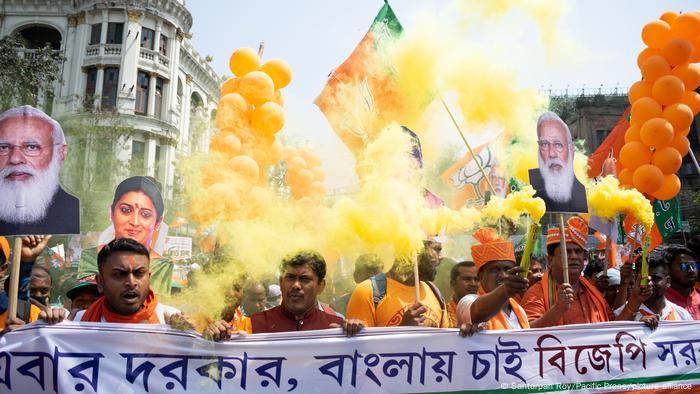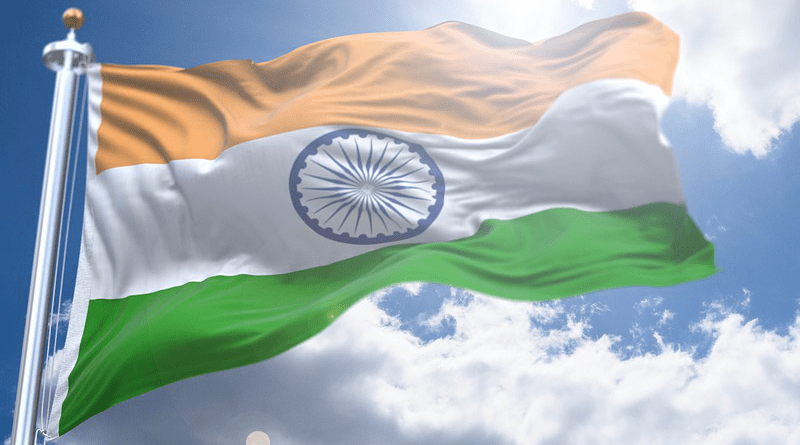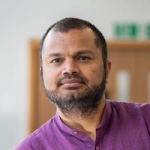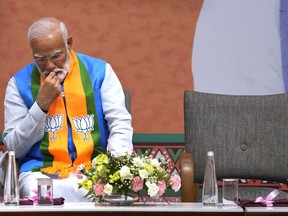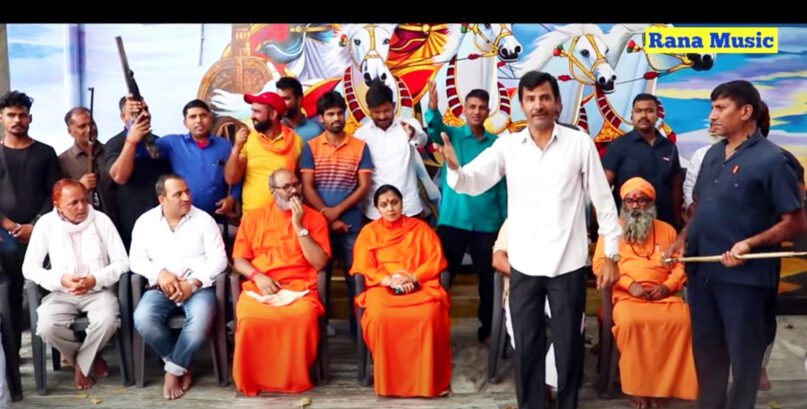Bulldozer is a Sign Hindutva is Flat
The author searches for meanings in the symbol of a bulldozer as they are unleashed on the streets of India to demolish all in their path.
Brahma Prakash
24 May 2022
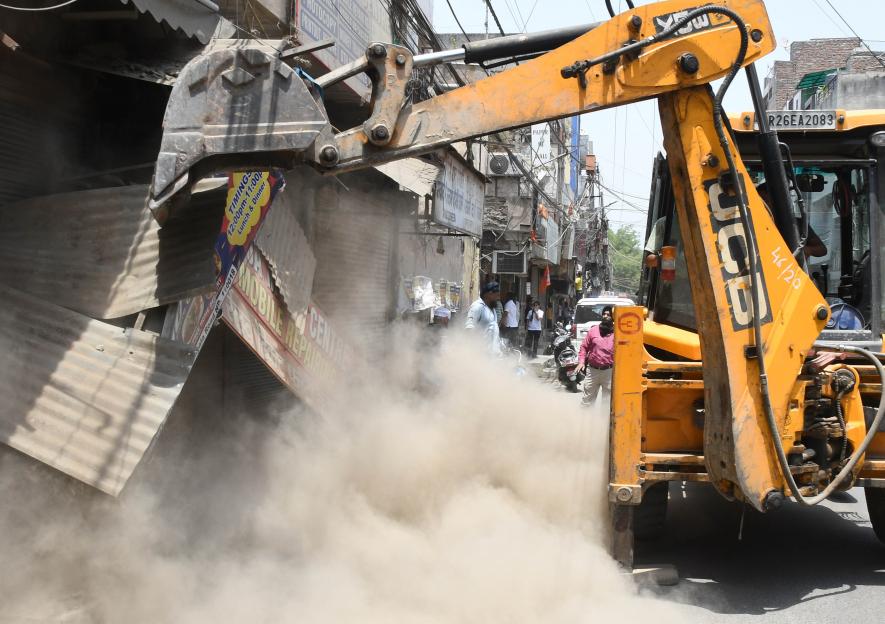
Image Courtesy: Tribune India
Like my ideologue, John Berger, I keep looking for a figurative image to understand the art and ideology of our time. For some time now, I have been searching for a complex definition of Hindutva: Its possible grey areas. Its coated meanings. Its teeth hidden in the tongue and belly like a bulldozer itself. I was looking for a figurative image that captures its dynamite power. Its unbridled emotions. Its automobility. I looked for a body and machine that captured its muscle and movement. Its muscular politics.
I was trying to understand the electric power of Hindutva that makes the words viral and puts the body in a trance. Perhaps an installation work of Hindutva that instils the fear of aligning aesthetics and anaesthesia together. I was looking for an artefact. An object that has cultic and exhibitory values but can equally cut the body like the swords of the Ram Navami procession. I was looking for an image that brings artillery and artefact together. Music and terror together. Slogan and silence together. Fun and violence together. I was looking for a toy of Hindutva that steals the love and instils the violence in children’s minds, like the toy gun culture of the US empire. I was looking for the object that rolls all these things together in one bundle like a bulldozer itself.
The figurative image for the Hindutva that I have found is that of a bulldozer—moving and bulldozing. It was open, out there, in body and spirit, politics and procession, sign and sensation, mobs and automobility, manhood and machinehood. It is a device that becomes biopolitical as well as geopolitical in its domination. It moves to demolish; it moves to displace; it moves to dominate. It moves to decimate. It moves to dismiss any prospect of dialogue. It moves to move the earth where one stands. It moves to create a new site for the settlers at the expense of the livelihood of the others.
In India, the bulldozer does not remain a machine. It has become an artefact now. It has entered the popular psyche. There is a massive demand for bulldozers. People are offering it as wedding and birthday gifts. There is massive demand for bulldozer toys. A report says bulldozer pichkaris sold like cakes in Banaras during Holi. There are popular songs and music tracks dedicated to the device. The media is full of news and views of it. Leaders are trying to name themselves after it—bulldozer baba, bulldozer mama, brother bulldozer, and so on. Bulldozer is a new bull of Indian politics. In a medicine shop in Bihar, a young man was asking for a bulldozer (condom). I checked. In fact, there is a JCB condom. Its promotion says, “It restores the confidence and relieves you of the inferiority complex.” Clearly, the bulldozer is a sign of the insecurity of Hindutva masculinity.
FLATNESS OF HINDUTVA
I soon realised that Hindutva doesn’t hold complexity. It simply cannot. It is not interested in complex seeing. Perhaps we do not need a complex definition for Hindutva. Bulldozer is a sign that Hindutva is flat. It wants to excavate everything; the soil that nurtures the soul, the food that nourishes the body, and the home that gives us a sense of belonging. It wants to dig out everything. It plans to smoothen out history. It wants to cut down the raising hands. It wants to roll down the raising heads. It wants to make everything flat and transparent, going with the agenda of neo-liberal politics. For Hindutva, everything is an exhibition, from faith and religion to nationalism. It is a remarkable show of politics on a spectacular level. How will we know unless you show? It is a neo-liberal formation of Hinduism in destructive form. Some say the bulldozer brings development.
Of course, there is a difference between Hinduism and Hindutva. But not in the way the liberals want to show us; Hinduism is good, Hindutva is bad. The differences lie in the ways they disclose themselves. Hinduism maintains pretensions, Hindutva is flat. One is ceremonial, the other is a show. When it comes to caste hierarchy, let us be brutes; if Hinduism is cunning, Hindutva is crude. What Hinduism does with its’ accommodating ideology’, Hindutva does it by othering! What lower castes were to Hinduism, Muslims are to the Hindutva. One maintains its ideology through hegemony; the other wants to maintain it by brute force symbolised by the bulldozer. Hate remains the common, and so the hierarchy.
One cannot hide by saying Hindutva is dangerous for Hinduism. In fact, Hindutva has given a new lease of life to Hinduism, which was facing a crisis from its lower castes. Check the geography. Hinduism has expanded its territory. The expansion becomes only possible through the ideology of Hindutva. The Hindutva of today is the Hinduism of tomorrow. What we are facing is the normalisation of Hindutva ideology as Hinduism. Hindutva is a general manifestation of Hinduism in a neo-liberal regime. We can say that Hindutva is not an aberration. It is the religion in its true Sanatani sense.
One cannot hide by saying Hindutva is inspired by western ideology; it has its Indian roots too. Did we forget its history: how dissenters were punished, women were burnt, and Buddhism was crushed in its own land? What we are witnessing is new but not so new. Do we believe that the hatred we see today was made in seven or ten years? It has been accumulating for years and is outpouring now. It has found its opportune time and moment.
The bulldozer is a sign that Hindutva is flat! Made of iron, its heart is flattened, and its eyes are flattening. It sees nothing. It hears nothing. It wants to make everything flat. It believes in the uniformity of all. The most insidious thing Hindutva does with life and culture is make everything flat. It sees things in black and white—you are a Hindu or a Muslim. You are nationals or anti-nationals. You are with Us or against Us. Its art, rhetoric, epics and sculptures typically follow and fall on this line. It makes everything flat. Have you seen the Bollywood movie? The Kashmir Files? In the movie, politics falls flat, and so does difference, without addressing the gaps. See the sheer flatness of the Statue of Unity, the world’s tallest monument, standing in front of the Narmada; it is spectacular. It asks for the gaze but does not unveil. It does not gape. It remains straight. Nothing is better than a bulldozer to represent this art of Hindutva. Flat. Brute. Massive. A spectacular machine. It does not hide anything. It does not have revealing power. Flatness becomes its clarion call. The art of bulldozer has a flatness of aesthetics. It reminds us of futurism—the art of the fascists.
If Hinduism is represented by the figure of a Brahmin with a ponytail, Hindutva reminds me of the figure of Brahmarakshas. In many folk narratives, the figure is shown as a huge but mean figure. It is a scary figure with horns and tentacles on his head and a ponytail. He hangs upside down on a tree. Like a bulldozer, the figure has a swishing tail, carnivore teeth and sharp nails. Despite their differences, Brahmins, Brahmarakshas and bulldozers keep looking for sacrifices. Sometimes they capture the mind. Sometimes they rip apart the body; sometimes, they rip apart the land.
BULLDOZER, TOO, HAS A HISTORY
The deployment of bulldozers against the minorities might be new in India, but it has a long genocidal history. Before the bulldozer came into the world, ‘bulldozer’ was the term deployed to intimidate Black people in parts of the United States. Bulldozing was used to describe intimidation by violent and unlawful means. The lawlessness of the bulldozer is not new, nor is the violence inscribed in the term. In the United States of the 1870s, the term “bulldose” was used for administering a large and efficient dose of any medicine or punishment.
The first recorded use of the term goes back to 1876, when its meaning and chilling effect were there but not yet the machine. Ahead of the US presidential election of 1876, Black American voters were on the receiving end of severe beatings and lashings for participating in their rights in the form of “bulldose”—“a dose fit for a bull”. They would be thrashed, whipped and often lynched. “Many were bulldosed into silence,” writes Andy Hollandbeck in In a Word: The Racist Origins of ‘Bulldozer’. He also writes that bulldozing got a clear meaning, ‘to coerce or restrain by use of force’. The invention of the massive machine made the term more concrete. Bulldozer brought the figurative image of its powerful meaning: using brute force.
The arrival of the bulldozer in India is not a coincidence; it symbolises the ideology of the time. The bulldozer does not move much, but it marks the genocidal connection beyond geographical boundaries. It was there against the Blacks in the United States. It is there in China against the minorities. It is used in Palestine by Israeli authorities. It has been at the centre of indigenous and ethnic displacement across the world. In this regard, Pranay Samajula writes, “The fact that bulldozers have cropped up in both India and Israel as a chilling symbol of state repression itself is common to both cases: in both India and Israel, the far-right regimes that govern the two countries share a common vision of an ethnic-majoritarian apartheid state, and willing to go to extreme lengths to realise that vision.”
Long before the demolitions and displacements in Delhi and Madhya Pradesh, Israeli authorities deployed it against Palestinians in massive ways. The machine came, carrying legacy and meaning, and so did the chilling memories and effect. What is this connection between unknown territories? We are not sure if Indian authorities have learnt from white or Jewish supremacists, but their genocidal connection is clear. Their bulldozing connection is clear. So clear is its brutality of power and the flatness of its aesthetics.
Brahma Prakash is Assistant Professor of Theatre and Performance Studies at the School of Arts and Aesthetics, Jawaharlal Nehru University, New Delhi. The views are personal.
